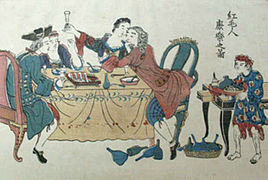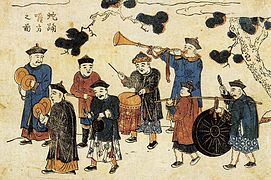Nagasaki woodblock prints
Nagasaki woodcuts ( Japanese 長崎 版画 , Nagasaki hanga ) are color woodcuts by mostly unknown artists, which deal with the life and activities of the Dutch and Chinese in Nagasaki in the 17th to 19th centuries .
background
After the closure of Japan in the 1630s, Nagasaki was the only gateway to foreign countries, namely China and Europe. Contacts with China had existed from ancient times, which were interrupted after 800, but which had been resumed in the cultural and economic field after 1400. They were given a separate area on the outskirts of Nagasaki as a base. Relations with Europe (see epoch of the Namban trade ) were maintained after the expulsion of the Catholic missionaries in the first third of the 17th century, but were limited to Protestant Holland. The Dutch and the Dutch East India Company were allowed to operate a trading post, first on the island of Hirado , then in Nagasaki, on the heaped foreland of Dejima .
When the ban on the use of European books was relaxed in 1710, Japanese scholars and artists traveled to Nagasaki to take advantage of the books available on Dejima. With this, interest in Dejima and the Dutch, the "redheads" ( 紅毛 , kōmō ) or "barbarians from the south" ( 南蛮 人 , Nambanjin ), grew in general .
Nagasaki pictures
The broader term “Nagasaki pictures” ( 長崎 絵 , Nagasaki-e ) indicates that Nagasaki did not only produce woodcuts. Kawahara Keiga in particular not only drew Japanese objects at Philipp Franz von Siebold's instructions , but also captured Dejima and Nagasaki in pictures. Another type of "Nagasaki picture" goes back to the Chinese painter Shen Quan , called Shen Nanpin. Shen only stayed in Nagasaki from 1731 to 1733, establishing the Nanpin style in Japan from Nagasaki .
photos
Hokusai : Curious in Dejima
Remarks
- ↑ Christian literature remained forbidden
literature
- Ramming, Martin: Japan Handbook . Steiniger.Verlage Berlin, 1941.








